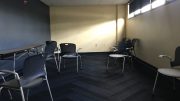Nicole Stone/Assistant News Director
The relationship society has developed with visual forms of communication arises from the onset of increasing access to technology over the last century; however, it is a relationship that had its genesis ages ago, according to a professor.
“There’s been an increasing use of visuals over the past century; partly mediated by technology,” Ken Lipartito, a doctor of history and a professor, said. “We’ve always used visual forms of communication. Written language is relatively recent in human existence and not every society had written language.”
One such example, according to Elio Arteaga, a professor of Visual Design for Global Media, is that of the cave paintings found in Lascaux, France.
“That’s how paleolithic humans communicated with each other – visually. Throughout human history, there have always been sculptures and art which is our form of communicating visually,” Arteaga said.
This dependence on visual expression is not limited to ancient cave paintings or hieroglyphics and extends into modern day languages as well.
“Some written languages like Chinese are based on ideographs,” Lipartito said.
During the Middle Ages, according to Lipartito, religious manuscripts often heavily combined text and imagery in a way that foreshadowed the combination of visuals and text in later periods of history like today.
“There are people who claim that this increasing use of visuals alongside the growth of written and text as a return to the Middle Ages,” Lipartito said.
Arteaga said that millennials, in particular, are the product of the “age of the internet” and are more in tune with technology, especially the later millennials who have grown up in an environment where the internet has always existed.
Lipartito, on the other hand, said that the association made between millennials and visual communication is somewhat of a deception.
While we have a tendency to attribute the shift towards emoji, memes and other forms of visual expression as a generational characteristic of millennials, it’s more a matter of time and place.
“In some ways, these technologies now allow people of all ages to do things that perhaps required specialized training in the past. You could say there is something of a democratization. I’m not 100 percent sure it’s as simple as younger versus older.
If you grow up in a world where these things already exist, you’ll just adopt them much more easily,” Lipartito said.
Images carry connotations or a feeling they evoke. Lipartito, who wrote an article about the myth of subliminal advertisements, said that while there is no such thing as advertising that is truly subliminal, there is, however, an assigned connotation to recurring images in our society, such as memes.
“Often what people mean by subliminal is connotation… there is this idea that something like the meme, which has become so much a part of the everyday language of life that when you see it, you know what it means,” Lipartito said.
Lipartito also added that memes, which could be considered to be tropes, phase in and out of time.
If you looked at images from fifty years ago, you would have a tough time figuring out what they’re trying to get at; whereas, if you were born 50 years ago, or lived 50 years ago, you would get it instantly,” Lipartito said. Emoji’s, according to Arteaga, bear the same connotative capabilities.
“Emoji is a universal visual language that anyone can understand. It transcends culture, it transcends languages. A heart pretty much means love everywhere,” Arteaga said.
Arteaga additionally mentioned that the standardization of emoji has been taken up by the Unicode Consortium on emojipedia.org where as of June 2017, 2,666 emoji are catalogued. The Unicode Consortium is a non-profit organization that maintains and standardizes software internalization data.
“It’s a unique visual language that, especially millennials because of their connection to electronic devices have embraced and made part of their culture,” Arteaga said.
There are a few criteria that a future emoji must meet before being added, according to Arteaga.
“It has to have demand already built in… it has to be universal; it can’t be too specific or too vague either,” he said.
While emoji, memes and gifs have become ingrained in our culture, text and imagery are destined to exist in a symbiotic relationship, according to Arteaga.
“You can paint pictures with text. You can also supplement that text with images,” he said.
Our inclination toward visual forms of communication, Arteaga said, has been facilitated by the advent of technology and can be attributed to both beauty as well as the ability to communicate universally.
“It’s like you’re looking at art. You can appreciate even a simple emoji of the thinking person – with a hand on the chin and a furrowed brow; pensive,” he said. “Just as a cartoon, it’s very expressive and communicative. It’s pleasing to look at too.”
Photo Credit: Jhaymesisviphotography
Modifications: Blurring of logo







Be the first to comment on "Millennials perpetuate a unique relationship with visual communication"